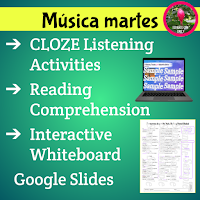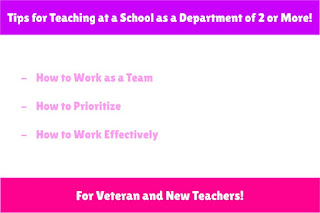Engaging Classroom Routines for Spanish Class: Music Tuesday (Música martes)
How do you keep students engaged in Spanish class?
By having fun and interesting bellringer routines!
Starting Spanish class with consistent routines is crucial for several reasons.
It sets the tone for the rest of the class period
It saves you time of having to reinvent the wheel, and it’s a part of your lesson plans that you don’t even have to think about once you get the hang of it!
It helps students transition into their Spanish mindset, either with a fun warm up activity, or reviewing content from yesterday’s lesson.
It creates a sense of structure and predictability - students do better when they know what to expect!
It provides students opportunities to engage with the target language, in ways they wouldn’t otherwise
It reinforces students’ language skills they already have
It can be a natural way to circle back to previous vocabulary or grammar concepts they already learned, especially when you intentionally select the music, memes or jokes for the week!
Click Here to Pin & save this blog post to read later!
In this blog post, I'm excited to share with you one of my students’ favorite classroom routines - Música Martes - and how I integrate it into my Spanish class as a fun and effective way to enhance students' language skills and cultural awareness.
You may ask, why música martes, not miércoles?
Well, my first year of teaching, I made every Thursday “Juego jueves”, which meant 2 super engaging lessons back to back, Wednesday and Thursday, so I chose to have a meme on miércoles, and música on martes. Click the underlined words, to read more about how I incorporate meme miércoles, and jaja jueves.
I started with música martes when I was student teaching, but really grew into making it a larger part of a lesson over the years.
Initially, I would pick a song that had some sort of grammar concept we were learning about, or I’d pick an artist or band from a certain Spanish-speaking country I wanted to connect to our unit.
That’s fine, and I still do that for certain units such as Mandatos, Spanish commands, but I found that I spent too much time trying to find a song that fit all the criteria - appropriate lyrics, catchy song, hopefully appropriate music video, and lyrics that fit the grammar concept for the week.
It wasn’t a good use of my time, so I moved on from that quickly, and chose to create música martes bellringers that included reading comprehension biographies about the artists and bands, maybe some background info about the song if there was any, and then do some CLOZE style activity with part or all of the lyrics.
It was a lot of “homework” up front, giving myself weekly music presentation projects for a whole year, but what resulted was being able to reuse these lessons year after year. I have so many música martes presentations created, but not enough time to post them all, but you can check some of them out here. This lasts 1 Quarter + a bonus song (10 weeks total). It’s my student’s favorite day of the week, in terms of my weekly bellringer routines. If you want me to post more of my música martes resources, comment below!
Click to Pin & save this idea for later!
Here’s the general layout of how I do música martes:
As students are walking in, have the google slides up showing the first slide with the reading comprehension biographies on the board.
Teach kids the expectations that as they walk in and wait for class to start, they should be pre-reading the slide, trying to understand what they can.
Once the bell rings, you take care of what you need to (attendance, etc.), read the slides to students.
If it’s lower levels, read it to them, pausing to ask clarifying questions about the meaning, referencing words on the posters around your room, or previous words, tenses, verbs they’ve already learned. I gesture a ton when I’m doing this with beginning Spanish 1, sometimes reading 1 sentence, using my laser pointer to point to words they know, having them translate out loud. Especially if it’s the first couple of months of Spanish 1, I then clarify the sentence in English.
If it’s upper levels such as end of Spanish 2 and beyond, I like to have students work with an elbow partner working out the meaning, then I read or they read parts, and we translate together.
It’s a lot of back and forth dialogue no matter the level!
Once we’ve read through the biographies, we move onto the CLOZE lyrics.
I have slides where a portion of the song is written in English on one side, and Spanish on the other. Part of the English lyrics are missing, and students have to figure out what’s missing. I have the slides animated, so as they say aloud the missing English words, I click my laser pointer and the correct word pops up for them!
There’s also a printable option of these slides that I sometimes give students ahead of time, to start figuring out the missing English translations, while I take attendance.
I really find the CLOZE lyrics a beneficial time to review vocab and grammar concepts such as adjectives coming after the noun, etc!
Lastly, we watch the music video if I deemed it appropriate! Sometimes if we are running behind schedule, I’ll just show part of it.
If the music video isn’t appropriate, I still want them to hear the song, so we do the Partner Highlighter race game with the word clouds made out of the lyrics. You can read about how to play this game here.
To conclude, I ask the students their opinions of the song and the video, gesturing and referencing my opinion posters to help aid them in their brief discussion.
You may be asking yourself a few of these questions, and I’ll address them below:
What if I get observed while teaching a música martes lesson?
I’ve been observed during one of these lessons. My principal loved it! He doesn’t know Spanish, and he told me he didn’t know what we were talking about, but he said it was so cool to see how much Spanish we were using in class, and that the class knew what was going on.
I do encourage having a few “reasons” why this matters up your sleeve, in case you’re questioned on it.
Here are mine, and you can read about this in more detail with my other blog post.
I can describe (in Spanish or English) the type of music, where artists are from, other facts about the artists, & the general theme of what the song is about.
Purpose:
A celebration of Hispanic culture & language
Introduce students to new songs and encourage them to actively engage with culture & language
Create excitement for language learning by incorporating authentic Spanish resources
How do I know if it’s appropriate for my class?
First of all, nobody knows your district, school, and class better than you. If your gut says the music video might be too risque, then don’t show it!
If the lyrics are clean, then do the listening activities like CLOZE listening where students listen and fill in the blanks with or without a word bank
Create a word cloud of the lyrics, and do a partner highlighter “race”. You can read more about how I do this activity with this blog post.
How do I get through the curriculum AND add this?
Música martes can be as short as 5 minutes, or it can take 10-15 minutes
Like I said above, you can choose to find a relevant song based on the vocabulary or grammar you’re teaching about, and then that makes it a part of the curriculum!
If you incorporate music in Spanish class, comment below!
How do you use music in the classroom?
Looking to try this out for free? Check it out here!





.jpg)